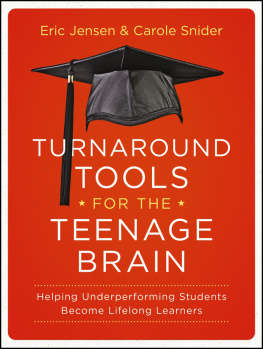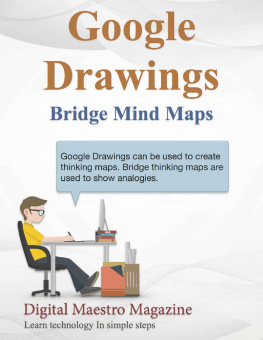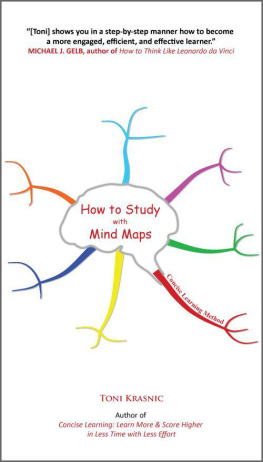STUDENT SUCCESSES With
THINKING
MAPS
SECOND EDITION
School-Based Research,
Results, and Models for
Achievement Using Visual Tools
DAVID N. HYERLE | LARRY ALPER
Foreword by Patricia Wolfe


FOR INFORMATION:
Corwin
A SAGE Company
2455 Teller Road
Thousand Oaks, California 91320
(800) 233-9936
Fax: (800) 417-2466
www.corwin.com |
SAGE Ltd.
1 Oliver's Yard
55 City Road
London EC1Y 1SP
United Kingdom |
SAGE India Pvt. Ltd.
B 1/I 1 Mohan Cooperative Industrial Area
Mathura Road, New Delhi 110 044
India |
SAGE Asia-Pacific Pte. Ltd.
33 Pekin Street #02-01
Far East Square
Singapore 048763 |
Acquisitions Editor: Hudson Perigo
Associate Editor: Allison Scott
Editorial Assistant: Lisa Whitney
Production Editor: Cassandra Margaret Seibel
Copy Editor: Melinda Masson
Typesetter: C&M Digitals (P) Ltd.
Proofreader: Theresa Kay
Indexer: Jean Casalegno
Cover Designer: Scott Van Atta
Permissions Editor: Adele Hutchinson
Copyright 2011 by Corwin
All rights reserved. When forms and sample documents are included, their use is authorized only by educators, local school sites, and/or noncommercial or nonprofit entities that have purchased the book. Except for that usage, no part of this book may be reproduced or utilized in any form or by any means, electronic or mechanical, including photocopying, recording, or by any information storage and retrieval system, without permission in writing from the publisher.
Printed in the United States of America
Library of Congress Cataloging-in-Publication Data
Student successes with thinking maps: school-based research, results, and models for achievement using visual tools/editors, David N. Hyerle and Larry Alper; foreword by Patricia Wolfe.2nd ed.
p. cm.
Includes bibliographical references and index.
ISBN 978-1-4129-9089-9 (pbk.)
1. Visual learningUnited States. 2. Learning, Psychology of.
3. Thought and thinking. I. Hyerle, David N. II. Alper, Larry.
371.335dc22 2010041858
This book is printed on acid-free paper.
11 12 13 14 15 10 9 8 7 6 5 4 3 2 1
Contents
List of Figures
and Tables
FIGURES
TABLES
Foreword
T he brain remembers what it has seen because humans are intrinsically visual beings. The eyes contain almost 70% of the body's sensory receptors and send millions of signals every second along optic nerves to the visual processing centers of the brain. It is not surprising that the visual components of a memory are so robust. And it is not surprising that when teachers use visuals in the classroom to represent concepts, their students retain the concepts longer.
Visuals not only are powerful retention aids but also serve to increase understanding. Imagine trying to comprehend governmental structure or the operation of an internal combustion engine without an accompanying diagram. The ability to transform thoughts into images is often viewed as a test of true understanding.
Many studies have demonstrated the facilitating effect of visual representations on learning and memory. Bull and Wittrock (1973) reported a study examining sixth graders understanding and recall of vocabulary words using two different strategies. One group memorized the dictionary definitions of the words, while a second group illustrated the meaning of the words. The second group's understanding and retention of the words were much higher. Another study, concerned with learning Spanish vocabulary words, taught students to use an imagery process that linked the sound of the word to an image of a concrete noun in English. The students retention of the words increased from 28% to 88% (Atkinson & Raugh, 1975).
The Thinking Maps program takes full advantage of the natural proclivity of the brain to think visually. The authors describe Thinking Maps as a language of visual tools grounded in the thinking process, a most neurally apt description. Neuroscientists tell us that the brain organizes information in networks and maps. What better way to teach students to think about ideas and organize and express their ideas than to use the very same method that the brain uses.
This book provides an invaluable way to help our students truly understand and retain the concepts behind the facts, and to do this in an exciting and motivating way.
Patricia Wolfe
Coauthor, Building the Reading Brain
REFERENCES
Atkinson, R., & Raugh, M. R. (1975). An application of the mnemonic keyword method to the acquisition of a Russian vocabulary. Journal of Experimental Psychology: Human Learning and Memory, 104, 126133.
Bull, B. L., & Wittrock, M. C. (1973). Imagery in the learning of verbal definitions. British Journal of Educational Psychology, 43, 289293.
Wolfe, P., & Nevills, P. (2004). Building the reading brain. Thousand Oaks, CA: Corwin.
Preface
RENOVATION IN PROCESS
I remember all too well when my wife and I were remodeling our small cabin in the woods of New Hampshire after we realized that our family, and our home offices, needed more space. We added two rooms, a home office, and a garage. The renovation was a difficult process as we lived in a reconstruction zonemuch more difficult than building a new housebut in the end the core of our home and the feeling were very much the same and we adapted to our new life. The renovation analogy maps nicely onto this second edition of Student Successes With Thinking Maps. We let go of very little, and many authors revised their chapters by adding significant new insights, data, and stories within the framework we had established. We also have added three new chapters with plenty of room for future growth: one on the deep connections between brain research and cognition, another focused on inquiry-based learning in science, and a closing chapter on bifocal assessment using Thinking Maps for seeing the formative growth of cognitive development and content learning simultaneously.
Books offer an array of starting points for new discoveries, so we also have added virtual rooms for you to explore beyond this renovation. The first edition, which was published in 2004, and the expanding work with Thinking Maps around the world inspired me to start up a nonprofit foundationthe Thinking Foundationthat supports continuing research, social networking, and broadcasting of results within and beyond the educational community. Many of the authors within this book have continuing updates, video clips, and even complete case studies placed on our website ( of this book by Marjann Ball. Sometimes we must renovate, and sometimes we need to start anew in the way we work; the transformative story of Pass Christian is written by Suzanne Ishee. A teacher in Pass Christian, Suzanne tells of amazing educators who moved quickly to fully reengage the minds of Mississippi in their classrooms.
Of course, when any kind of renovation or revision is being contemplated, you have to take into account that the world around you has also changed and, thus, so has your vision of what is possible. The results and research included in this book seem even more relevant now that the educational community is responding to the needs of our time: Since 2004 when the first edition was published, the educational community has been using the symbolic power and realities of the 21st century to see stark problems. Educators still haven't fully escaped and shifted the early-20th-century paradigm dominated by rote learning and teaching, closed-ended standardized testing, and classroom inequities that act to lessen the chances of successful school and work experiences for our children of color, those who come to school with the need to learn English, and those in poverty.
Next page






